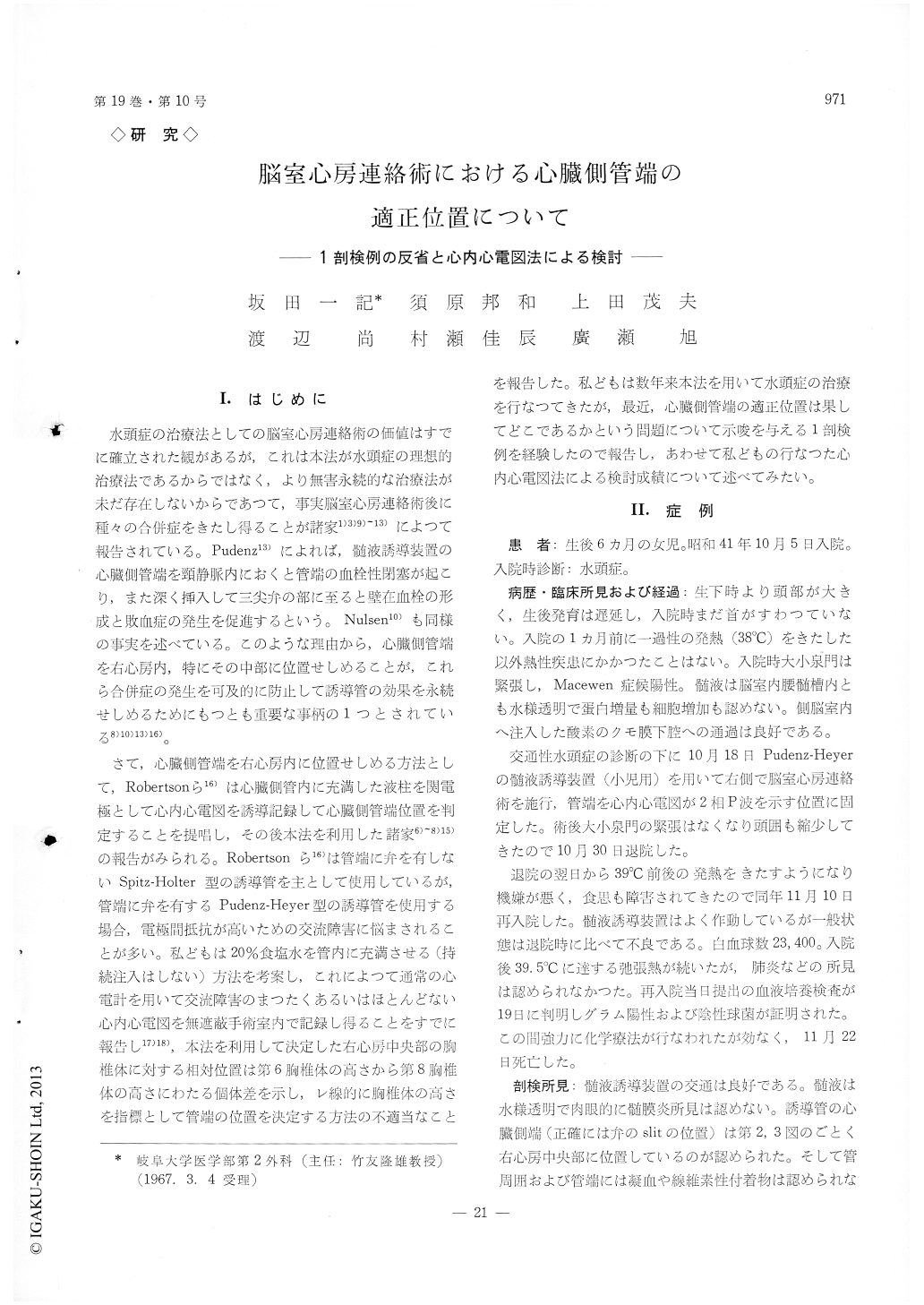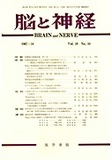Japanese
English
- 有料閲覧
- Abstract 文献概要
- 1ページ目 Look Inside
I.はじめに
水頭症の治療法としての脳室心房連絡術の価値はすでに確立された観があるが,これは本法が水頭症の理想的治療法であるからではなく,より無害永続的な治療法が未だ存在しないからであつて,事実脳室心房連絡術後に種々の合併症をきたし得ることが諸家1)3)9)〜13)によつて報告されている。Pudenz13)によれば,髄液誘導装置の心臓側管端を頸静脈内におくと管端の血栓性閉塞が起こり,また深く挿入して三尖弁の部に至ると確在血栓の形成と敗血症の発生を促進するという。Nulsen10)も同様の事実を述べている。このような理由から,心臓側管端を右心房内,特にその中部に位置せしめることが,これら合併症の発生を可及的に防止して誘導管の効果を永続せしめるためにもつとも重要な事柄の1つとされている8)10)13)16)。
さて,心臓側管端を右心房内に位置せしめる方法として,Robertsonら16)は心臓側管内に充満した液柱を関電極として心内心電図を誘導記録して心臓側管端位置を判定することを提唱し,その後本法を利用した諸家6)〜8)15)の報告がみられる。Robertsonら16)は管端に弁を有しないSpitz-Holter型の誘導管を主として使用しているが,管端に弁を有するPudenz-Heyer型の誘導管を使用する場合,電極間抵抗が高いための交流障害に悩まされることが多い。私どもは20%食塩水を管内に充満させる(持続注入はしない)方法を考案し,これによつて通常の心電計を用いて交流障害のまつたくあるいはほとんどない心内心電図を無遮蔽手術室内で記録し得ることをすでに報告し17)18),本法を利用して決定した右心房中央部の胸椎体に対する相対位置は第6胸椎体の高さから第8胸椎体の高さにわたる個体差を示し,レ線的に胸椎体の高さを指標として管端の位置を決定する方法の不適当なことを報告した。私どもは数年来本法を用いて水頭症の治療を行なつてきたが,最近,心臓側管端の適正位置は果してどこであるかという問題について示唆を与える1剖検例を経験したので報告し,あわせて私どもの行なつた心内心電図法による検討成績について述べてみたい。
Ventriculo-atrial shunt operation is the most popular treatment for hydrocephalus at the present. However, its serious complications have been reported by vari-ous authors. Among these complications, obstruction of the cardiac catheter by formation of thrombi and septicemia are important ones. For its prevention, placement of the catheter tip at the center of the right atrium is believed to he essential. The endo-cardiac electrocardiography method (Robertson, et al.) is an excellent one for this purpose. We regularly are recording satisfactory endocardiac electrocardi-ogram from a Pudenz-Heyer cardiac catheter by fill-ing (not flushing) the catheter with 20% saline solu-tion. Recently we experienced an autopsy case of hydrocephalic infant who had undergone ventriculo-atrial shunting and succumbed to postoperative septicemia. In this case the catheter tip was found to be located exactly at the right mid-atrium and there was localized infectious endocarditis with nodular hypertrophy in the tricuspid valve region. We supposed a possibility that the intracardiac catheter tip might have touched the tricuspid valve at the time of neck anteflection, thus producing the locus minoris resistentiae. In another case of ventriculo-atrial shunting we examined this possibility during the operation by observing changes in endocardiac electrocardiogram caused by anteflection of the neck. It was found that the neck flection caused a movement of the catheter tip for half a distance between the inferior border of the superior vena cava orifice into the right atrium and the tricuspid valve. It is therefore possible that the catheter tip placed at the mid-atrium while the neck is extended during the operation reaches the tricuspid valve when the neck is anteflexed postoperatively. Whether the catheter tip should be placed at the biphasic P point while the neck is extended, or it should be placed at the biphasic P point while the neck is anteflexed, is the problem to be solved in future, but at the present we are of the opinion that the latter is a safer meth-od.

Copyright © 1967, Igaku-Shoin Ltd. All rights reserved.


